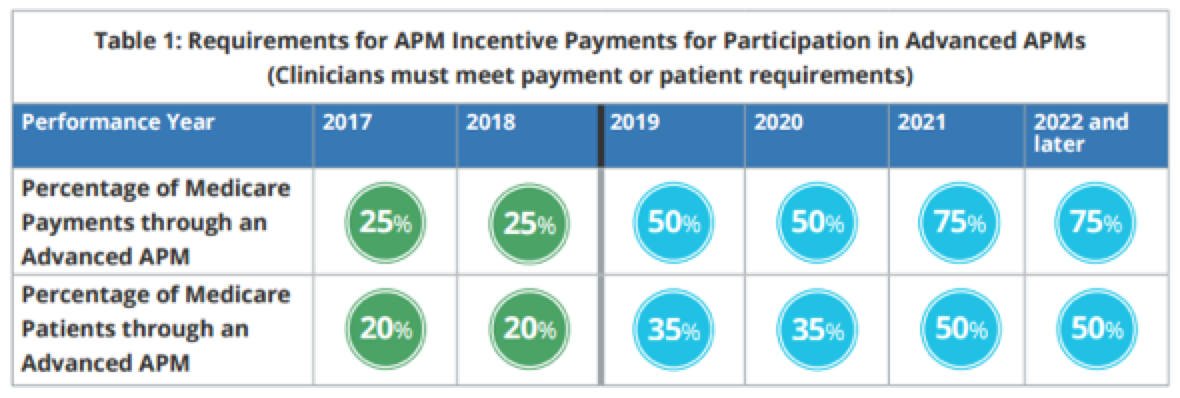 Yes, I know Mr. Shakespeare would not be happy with that title, but on this first day of May I am afraid we are going to be revisiting that famous soliloquy from Hamlet as we unpack the long-awaited publication of the method by which CMS intends to determine who within an Advanced Alternative Payment Model (Advanced APM) is considered to be a Qualifying Participant (QP). Spoiler alert: Most of the content in this post is only relevant to those of you participating in an ESCO or a different Advanced APM. I invite the rest of you to join the fun, or return next week when our content is refreshed!
Yes, I know Mr. Shakespeare would not be happy with that title, but on this first day of May I am afraid we are going to be revisiting that famous soliloquy from Hamlet as we unpack the long-awaited publication of the method by which CMS intends to determine who within an Advanced Alternative Payment Model (Advanced APM) is considered to be a Qualifying Participant (QP). Spoiler alert: Most of the content in this post is only relevant to those of you participating in an ESCO or a different Advanced APM. I invite the rest of you to join the fun, or return next week when our content is refreshed!
To suffer the slings and arrows of outrageous fortune
Okay, perhaps it’s not that bad. But an objective observer must admit the new Quality Payment Program (QPP) cast upon us by MACRA is not a walk in the park for most docs. The Acumen blog team has done a wonderful job simplifying the thousands of pages necessary to explain the new world in which all of us have been living for the last 4 months, but who’s counting. As noted previously in this blog, in 2017 the Slings and Arrows of MIPS will not sting as much as in future years because we are provided the option to gently wade into the QPP pool.
Or to take arms against a sea of troubles
Taking arms seems a bit of a stretch, but a number of you are participating in an Advanced APM or are contemplating doing so in the years ahead. Among the opportunities the Advanced APM offers to the practicing nephrologist is the chance to avoid MIPS and, while you are at it, collect a 5% lump sum payment on your Part B book of business for your troubles. I can tell you that in my travels around the country, this is a very attractive option when it’s available. The Advanced APM that is tailor made for nephrologists is the ESCO. There are 37 of these in operation around the country, and if I had to guess, I would bet there are easily north of 1,000 nephrologists actively participating in one of these ESCOs today.
The whips and scorns of time
So that’s all there is to it? Simply sign up for the ESCO and hold out your hand waiting for the 5% check as you forget how to spell MIPS? Well, not so fast. Avoiding MIPS and collecting the 5% bonus only occur if the participants within the ESCO are “anointed” Qualifying Participants. How do you become a QP, you might ask? A few short weeks ago our good friends at the agency finally decided to let us know.
The QP calculation comes down to a simple fraction. In the denominator are the patients who could potentially be attributed to the ESCO, and in the numerator are the patients who are actually in the ESCO. If that ratio is greater than 20% for the ESCO in 2017, then all of the providers on the ESCO participant list are considered QPs—they are excluded from MIPS in 2017, and in 2019 they will receive a 5% lump sum payment equivalent to their 2018 Part B book of business. In 2018 the same calculation will occur and if the QP hurdle is cleared, these providers avoid MIPS in 2018 and the bonus is based on their 2019 Part B allowable and paid in 2020. And so on and so forth…
Speaking of the “scorns of time”, what CMS described in detail (a mere 4-months late) was how they intend to define the denominator of this important fraction. That denominator includes 6 criteria:
(1) Is not enrolled in Medicare Advantage or a Medicare cost plan;
(2) Does not have Medicare as a secondary payer;
(3) Is enrolled in both Medicare Parts A and B;
(4) Is at least 18 years of age;
(5) Is a United States resident; and
(6) Has a minimum of (1) one maintenance dialysis service claim (which need not be with a dialysis facility that is affiliated with an ESCO); and (2) one Part B claim with an eligible clinician in an ESCO.
To sleep, perchance to dream
Item 6 on the hit parade above is what we’ve been waiting for since the end of 2016. Basically, the way this works is CMS will look at every physician on the ESCO participant list. They will add up all of the adult, US residents enrolled in Medicare A & B who are not in an MA plan, who receive dialysis for ESRD, and who have at least one encounter with one of the docs in the ESCO during 2017. That’s your denominator. The ESCO participant list is the numerator. They will check this fraction 3 times during the year. If at any of those 3 points during the year the ESCO clears the patient count OR the revenue hurdle below, ALL PROVIDERS in the ESCO are QPs for that year.
Note the 3 check points occur on March 31, June 30, and August 31. Due the necessity to permit a three months claims “run out” to occur, the ESCOs will be notified sometime during July 2017, October 2017, or January 2018 respectively. Importantly, if during any of these check points the ESCO clears either the patient count or the revenue QP hurdle, everyone is a QP this year and the calculation is not checked again until it’s time to do so for the 2018 performance year.
Be all my sins remember’d
I am rapidly running out of Shakespeare quotes so we must be near the end of this post! Suffice it to say, this is very good news for ESCO participants. Unless a very small fraction of the ESRD patients cared for the by the ESCO participants are receiving treatment in the ESCO dialysis facilities, it certainly looks like nephrologists in an ESCO will easily achieve QP status. While there is still work to be done in the ESCO itself, avoiding MIPS and collecting the 5% Advanced APM bonus is a remarkably attractive reward, one that might even draw Hamlet’s attention.
Do you have questions or comments about the QP calculation? Drop us a note and join the conversation.
 Terry Ketchersid, MD, MBA, practiced nephrology for 15 years before spending the past seven years at Acumen focused on the Health IT needs of nephrologists. He currently holds the position of Chief Medical Officer for the Integrated Care Group at Fresenius Medical Care North America where he leverages his passion for Health IT to problem solve the coordination of care for the complex patient population served by the enterprise.
Terry Ketchersid, MD, MBA, practiced nephrology for 15 years before spending the past seven years at Acumen focused on the Health IT needs of nephrologists. He currently holds the position of Chief Medical Officer for the Integrated Care Group at Fresenius Medical Care North America where he leverages his passion for Health IT to problem solve the coordination of care for the complex patient population served by the enterprise.
Image from www.canstockphoto.com





Leave a Reply